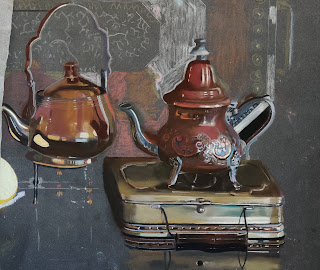Monday, February 7, 2022
Brasserie
Saturday, May 15, 2021
FUNGUS
I haven't posted here in a while. not because I haven't been painting, but because I have been exploring other mediums. However, after buying Dan Massad's Palmer Museum retrospective catalogue/monograph I thought I might like to try a stark image against a black background - something I hadn't done before. This striking image of a fungus was taken by by Mick Grant, who kindly gave me permission to use it..
This is the initial sketch and scribbled infill using pastel pencils on a grid drawn only where the image will sit.
Much of the caps is completed using a variety of soft pastels, Rembrandt, Sennelier, and Roché, and a contrasting black background is filled in using pastel pencils around the edges of the mushrooms, with Rembrandt black pastel sharpened to a point.
I started work on the stems, using mostly Rembrandt grey, blue grey, mouse grey, and green grey, and extended the black background.
Monday, October 7, 2019
Campsis after Rain
I'm going a little deeper into my method here. The first image is a photograph of the flowers reduced to 16 colours in Paint Shop Pro, with a 10 x 8 grid imposed (my support will be a 10 x 8 in. piece of Pastelmat).
Now you can use the colour palette in Paint Shop to make a swatch, so that the underpainting is reduced in complexity of colour although the tonal range is not altered.
I used this as basic palette to to the first sketch.
 |
| Campsis after Rain © Niall O'Neill |
Hibiscus after Rain
The first picture shows the support, some scribbled petals, and a colour chart of the few pastels used to get me to this point - CarbOthello in the main.
The pencils are fine for initial drawing, but not for painting, with the exception of the stigmas and pistil in the flower's centre. After checking all my blues, I decided on Sennelier 334, 335 and 336 as being the most suitable for colour and for a subtle movement of tone within the hue.
The dark centre was put in using Unison, and all the raindrops were outlined. The centre was enhanced with some subtle touches of very dark red from Roché. Once the petals were near completion I put in some Sennelier 434 dark blue to see how the background would show up the bloom.
It only remained to finish the leaves - not too much detail needed here - finish the background, and sign! The finished piece is on Pastelmat, 10 x 8 ins or 25 x 20 cms.
 |
| Hibiscus after Rain © Niall O'Neill |
Friday, March 15, 2019
Edgy about edges?
Thursday, March 7, 2019
Tea for the Tillerman
First off, I scribbled in some undercolours with pencils and hard pastels.
Based on the undercoat, I chose a selection of pastels that would be the main workhorses for the next phase. As you might be able to make out, it's a varied range of ochres, yellows, and umbers, and draws from Artisan Pastellier, Blue Mountain (the square ones), Sennelier, Rembrandt and a few Caran d'Ache. You can make out a colour reference on top.
Working from the top left, I started with the urn.
First overcoat on the lemon.
The lemon is large and bright, so I needed to check its value and chroma against the mooted background colour (Sennelier dark greens 178 and 179). Also the light green in the lamp.
The lemon was too light in value overall, so that needed adjustment.
The background was completed, with a contrasting dark for the surface on which the objects were placed. Reflections were painted in, and this is when I realised I had a painting 42 cm wide by 48 cm high, with a lot of empty space on top. So I took off 6 cm from the top to make it square.
 |
| Tea for the Tillerman © Niall O'Neill |
Wednesday, January 16, 2019
Coffee in style
I started off with a pencil scribble.
Coffee in Style, pastel on Pastelmat, 50 x 60 cms.
 |
| Coffee in Style © Niall O'Neill |












































